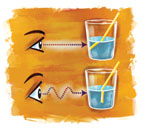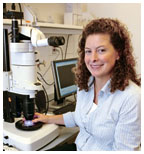
|
November 21, 2007: Notebook
BREAKING GROUND - Molecular
biology
Sustaining quality of life with age
The Etruscan relief, above, is being returned to Italy. (photos courtesy of the Princeton University Art Museum)
A Greek ceramic psykter, above, and an Italian loutrophoros, below, will remain on loan at the art museum for four years.
|
Art
museum to return ancient objects to Italy
Italian officials promise loans of art works, access for students
to excavation sites
The University Art Museum and the Italian government resolved the ownership of 15 objects from the museum’s collection at a meeting in Rome last month, ending nearly three years of inquiries and negotiations.
Four works at the museum will be returned to Italy by the end of this year, four have been transferred to Italian ownership but will remain on loan at Princeton, and seven others will continue to be owned by Princeton and held in the museum’s permanent collection, according to the agreement, signed Oct. 30.
Italian culture ministry officials first contacted Princeton in 2004 with suspicions that some of the museum’s artifacts had been removed illegally from Italy. After researching the artifacts, the museum transferred title on the ones “for which there were sufficient concerns regarding the objects’ provenance,” director Susan Taylor said in a statement. Taylor has maintained that all of the objects were obtained in good faith, an assertion that culture ministry lawyer Maurizio Fiorilli affirmed in an interview with the Associated Press.
While the University Art Museum’s collection will absorb a few losses, Princeton students could see gains from the agreement, which promises new access to excavation sites managed by the Italian ministry and loans of additional works to the museum. Details of those arrangements are being worked out, according to Princeton spokeswoman Cass Cliatt ’96. The agreement also maintained the University’s scholarly access to the transferred works, Cliatt said.
The Italian culture ministry’s initial inquiry focused on three pieces from the art museum’s collection, according to the University. The museum responded with details about the works in question in 2005 and began talks with the Italian ministry the following year. All three of the originally disputed works — an Etruscan relief from the 6th century B.C., a Greek psykter, or wine-cooling vase, from about 500 B.C., and a 4th-century B.C. Italian vase known as a loutrophoros — are now property of Italy, though the latter two will remain on loan at Princeton for the next four years.
Since 2006, Italy has repatriated artifacts from several American museums, including the Metropolitan Museum of Art in New York, the Museum of Fine Arts, Boston, and the J. Paul Getty Museum in Los Angeles.
This is not the first time that the Princeton museum has returned works
to Italy. In 2002, the museum voluntarily sent an ancient Roman sculptural
relief to the Italian government after discovering that it had been exported
illegally. A half-century earlier, the museum returned an ancient marble
goat head that had been stolen from storage during World War II. After
receiving the artifact, the Italian consul general in New York brought
it back to campus as a gift to the University. ![]()
By B.T.
To read PAW's 1953-54 coverage of the well-traveled marble goat head, click here.

Robertson
case cleared for trial
Judge focuses issues in ‘donor-intent’ lawsuit;
each side cites favorable rulings
A New Jersey judge gave lawyers for both the University and the Robertson family something to cheer in a series of pretrial rulings Oct. 25 designed to shape the legal issues that will be decided when the “donor-intent” lawsuit goes to trial.
The late Marie Robertson, wife of Charles Robertson ’26, donated $35 million worth of A&P stock in 1961 to set up the Robertson Foundation to support the graduate program of the Woodrow Wilson School in preparing students for government service. Robertson family members sued the University in July 2002, claiming that the University has not carried out the intent of their parents and seeking to take control of the foundation.
Superior Court Judge Neil Shuster ruled in favor of the University on two issues. First, the case will be decided by a judge and not a jury, as sought by the Robertsons. And he ruled that the foundation can spend gains realized on investments, rejecting the Robertsons’ request to limit spending to dividends and interest.
The foundation’s assets are now worth $880 million. More than $315 million has been spent on graduate programs of the Woodrow Wilson School, President Tilghman said in May. The Robertsons say they have spent about $20 million on the lawsuit thus far, while the University says it has spent about $22 million on the case.
In considering an issue at the heart of the lawsuit, Shuster rejected a University motion to rule that Princeton is and will remain the sole beneficiary of the Robertson Foundation. The Robertsons have sought to remove the University from any control or involvement with the foundation. Shuster declined to rule out that possibility until all the facts are heard at trial, but he said that ordering such action would be appropriate only “to remedy the most egregious and nefarious of circumstances.”
“The family believes the evidence of such wrongdoing is overwhelming and looks forward to introducing this evidence at trial,” said Ronald Malone, lead attorney for the Robertsons. Douglas Eakeley, a lawyer for the University, took a contrary view, saying that the judge “has set a very high evidentiary bar for the plaintiffs that we are confident they will not be able to clear.”
University lawyers pointed to the judge’s ruling that the trustees appointed by the University on the foundation board, where they hold four of seven seats, are not required to prove the “entire fairness” of their actions on behalf of the foundation. Eakeley termed the ruling “very positive,” saying that Shuster had ruled that there was “no inherent conflict of interest” in the way the foundation board was structured. Malone pointed out that the judge also ruled that “Princeton has fiduciary obligations to the Robertson Foundation, including the duties of loyalty and candor.”
While the Robertsons have asked that Princeton be ordered to repay more than $200 million in what they claim were expenses improperly billed to the foundation, last month’s rulings ordered a single transfer of $62,500 by the University — to repay a payment it admitted was made in error to a psychology professor in 1999.
In a series of rulings that totaled 355 pages, Shuster rejected a number of motions on the basis that more evidence will be required at trial.
“The judge has significantly narrowed the issues in providing
a road map for ending this case,” said Peter McDonough, University
general counsel. He said he hoped that what he termed “a sad, protracted
saga” would finally come to trial in 2008. ![]()
By W.R.O.

(STEVEN VEACH) |
Around the bend
Natural materials refract light in one direction — when you place
a straw in a glass of water, it always appears to bend toward the surface
— but researchers from Princeton, Oregon State University, and Alcatel-Lucent
have found a way to reverse that angle. The group, led by electrical engineering
graduate student Anthony Hoffman, created a novel material that bends
light in the opposite direction of naturally occurring materials by arranging
semiconductors in tiny alternating patterns. The patterns combine to modify
the material’s collective properties, according to a University
release. The new “optical metamaterial,” described in detail
in a paper published online by Nature Materials, could be used
in microscopy, communications, and sensor technology. ![]()

By studying memory and reproduction in a tiny worm, Coleen Murphy hopes to learn more about the genes involved in aging. (Frank Wojciechowski) |
BREAKING
GROUND - Molecular biology
Sustaining
quality of life with age
Coleen Murphy, an assistant professor of genomics and molecular biology, has a cartoon on her office door that shows a scientist holding an Erlenmeyer flask filled with a mysterious liquid. “It may very well bring about immortality,” the scientist tells a colleague. “But it will take forever to test it.”
Though Murphy studies aging and its genetic underpinnings, she does not expect to face the cartoon scientist’s eternal dilemma. Her aim is to understand the genes that contribute to quality of life, not just the ones that prolong it. Murphy’s lab studies biological processes that decline before death — specifically, reproduction, learning, and memory — in C. elegans, a tiny worm commonly used in biology labs. Learning about the genes that govern those activities in worms could help to identify analogous genes in humans.
At just one millimeter in length, a single C. elegans looks, to the naked eye, like an unremarkable speck of dust. But the little worms, Murphy says, are powerful models for research on aging. Their multicellular bodies provide more complexity than single-cell models like yeast and bacteria, and their short life span (normally two to three weeks) enables researchers to do experiments relatively quickly.
In one project, Murphy has taken a closer look at how the ability of C. elegans to reproduce declines with age. Using a finding from a study of genes in mice as a starting point, her lab regulated the same genes in C. elegans and doubled the amount of time in which the worms can reproduce. Murphy and her students are screening genes to find others that also could play an important role in reproduction. “We don’t think of [reproduction] normally as an aging process,” she says. “But if you back up, you find that for women, the first noticeable, age-related process that declines is reproduction.”
To study learning and memory in C. elegans, Murphy’s lab had developed a feeding method that encourages the worms to make a Pavlovian association between food and an unrelated chemical odor. In time, the worms become drawn to the odor, even when there is no food present. But the long-term memory that enables that association — one of the worm’s most complex functions — declines just a few days into the worm’s life, long before it shows other indications of aging, like slower body movements. By screening for those worms that maintain memory longer than their contemporaries, Murphy hopes to find the genes that extend memory function.
How much can scientists extrapolate from the life of a millimeter-long worm? Certainly there are limits, Murphy says. But there are some processes and genes that are conserved in evolution — the connection between the reproduction genes in C. elegans and mice is just one of many examples. Each study of model organisms brings scientists closer to understanding topics in human health, like age-related diseases, and Murphy’s lab is developing new techniques, using DNA microarrays, robotics, and automated imaging, to accelerate the rate of discovery.
“The real area we’re interested in is maintaining function
with age,” Murphy says. “The whole idea of decline, that it’s
necessary with age — I think that could be questioned.” ![]()
By B.T.

At Alumni Day ceremonies Feb. 23, JOHN ROGERS ’80, the chairman and CEO of Ariel Capital Management, will receive the Woodrow Wilson Award and LAWRENCE P. GOLDMAN *76, president and CEO of the New Jersey Performing Arts Center in Newark, will receive the James Madison Medal. The awards are the University’s highest honors for alumni. Rogers is being recognized for building Chicago-based Ariel into the nation’s largest minority-run mutual fund family and for his civic involvement. NJPAC, a centerpiece of efforts to revitalize Newark, celebrated its 10th anniversary last month.
The old mascot returns. (Beverly Schaefer) |
It’s now the PETER B. LEWIS ’55 Center for the Creative and Performing Arts. The center
was renamed in recognition of Lewis’ $101 million gift, the largest in University history, to support a broad expansion of arts facilities, faculty, and courses at Princeton. Lewis is a University trustee and the chairman of the Progressive Corp. “Peter Lewis has recognized that the University as an institution has now taken on the role of patron of the arts,” said Paul Muldoon, chairman of the center. “It’s a role we at Princeton embrace enthusiastically, but it’s a role we simply wouldn’t be able to envision were it not for the munificence and magnanimity of Peter Lewis himself.”
The University’s traditional TIGER MASCOT returned to the field
just one week after the athletics department unveiled what it termed “a
more spirited, healthy, athletic-looking” version at the Lehigh
football game Sept. 15. The new mascot costume, pictured in the Oct. 10
issue of PAW, was retired after an “internal decision” within
the athletics department, said Jamie Zaninovich, senior associate director
of athletics. Zaninovich declined to explain the reason for the change,
but said the department is “formulating a new plan that looks toward
next year” for the mascot.![]()






